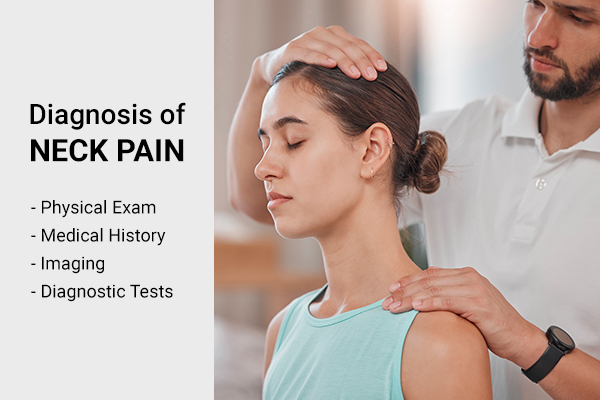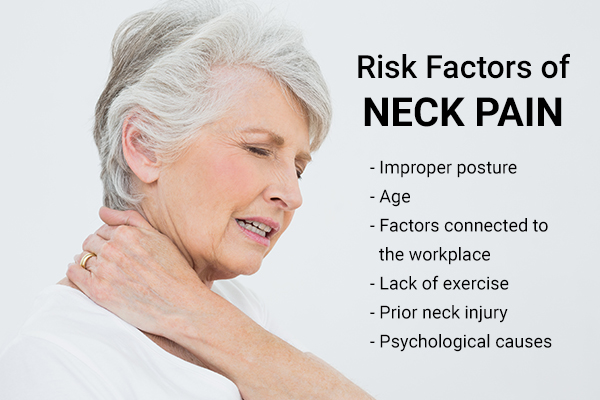In this article:
With the advent of remote working and advances in high technology, most people spend significant amounts of time on their laptops, phones, and other devices.

Sitting hunched over them for hours at a stretch can lead to health issues if ignored. The first sign of discomfort is usually felt in the neck muscles.
Pain that is specific and localized to a certain region, such as the back, neck, arms, and hips, is associated with short- and long-term health effects, which can vary from discomfort to issues with muscles, bones, or ligaments, (1) diminished quality of life, (2) and increasing cost of health care. (3)
Studies that are now available on location-specific pain are typically restricted to small or special populations and have little generalizability.
Causes of Neck Pain
Neck pain can be brought on by a number of factors, including poor posture, prolonged desk work without breaks, sleeping with your neck in an awkward position, and jerking your neck during exercise.
Neck pain can have many different causes. Some common causes of neck pain include:
- Muscle tension: This is often caused by poor posture, repetitive motions, or stress.
- Joint dysfunction: This can be caused by arthritis, vertebral disk problems, or other spinal abnormalities.
- Nerve compression: This can occur due to a herniated disk, pinched nerve, or other spinal condition.
- Injury: A fall, a blow to the head, or other trauma can cause neck pain. (4) If you have whiplash, be careful. Whiplash is a neck injury brought on by a quick head movement. Usually, it gets better in 2–3 months. (5)(6)
Symptoms of Neck Pain
Pain in the neck is a common problem, and it can have many different causes. Some people experience neck pain because of poor posture, while others may have an injury or condition that is causing the pain. There are many different symptoms of neck pain, and these can vary depending on the underlying cause.
The most common symptom of neck pain is a dull ache that is felt in the neck and shoulders. This pain may radiate down into the arms or up into the head.
People with neck pain may also experience stiffness, tenderness, or difficulty moving the head or neck. In some cases, neck pain can be accompanied by headaches, dizziness, or tingling in the arms or hands.
Sharp or dull aches might be felt in the neck, shoulder, and adjacent muscles as a result of neck discomfort. Even headaches, neck swelling, numbness, tingling, stiffness, and pain may result from this.
It might be challenging to carry out daily tasks when neck pain makes it difficult to turn your head in any direction. (7)
If you are experiencing any of these symptoms, it is important to see a doctor to rule out any serious underlying conditions.
However, there are also many simple things that you can do to help relieve your neck pain. These include maintaining good posture, using proper ergonomics when working or using computers, and exercising regularly to strengthen the muscles in your neck and upper back.
Treatment for Neck Pain
Many different types of medical treatments can be effective for neck pain. Some common treatments include pain medication, physical therapy, massage, and chiropractic care. (6)
If your neck pain is caused by a specific injury or condition, your doctor may recommend specific treatments to address the underlying cause. In some cases, surgery may be necessary to correct the problem. (7)
In most cases, however, conservative treatments such as pain medication, physical therapy, and chiropractic care can be effective in managing neck pain. If you have persistent or severe neck pain, it is important to see a doctor to rule out any serious underlying causes and develop a treatment plan that is right for you.
Diagnosing Neck Pain

Typically, a physical examination, medical history, and imaging studies are used to diagnose neck discomfort.
- Physical exam: A healthcare professional may assess the neck’s range of motion, strength, and reflexes during a physical examination. Also, they can check the neck for any areas of deformity, edema, or soreness. They could inquire about the nature of the pain when it first appeared, and any activities or postures that make it worse or better.
- Medical history: Questions concerning prior accidents, surgeries, and illnesses that may have contributed to neck discomfort may be part of the medical history. They could also inquire about any drugs or aspects of one’s lifestyle that might have an impact on one’s neck, such as posture, exercise, or stress.
- Imaging: If the physical exam and medical history indicate a need for more investigation, imaging tests may be recommended. X-rays, CT scans, and MRI scans are a few examples. Any bone abnormalities, disc herniation, or other soft tissue injuries that may be the source of neck discomfort can be found utilizing these imaging procedures.
- Diagnostic tests: To rule out underlying medical diseases such as arthritis, infection, or thyroid problems that could be causing neck pain, blood tests or other diagnostic tests may occasionally be prescribed. (8)
Depending on the unique situation and the probable reason for the neck discomfort, a particular diagnostic strategy may be implemented.
Risk Factors of Neck Pain
People of different ages and socioeconomic backgrounds can have neck discomfort, which is a frequent issue. It has been determined that several risk factors play a role in the emergence of neck discomfort.
According to studies, the following are some of the most prevalent risk factors for neck pain:

- Improper posture: Bad posture, such as slouching over a phone or computer, can overwork the neck muscles and cause pain.
- Age: As you grow older, your muscles and joints have a tendency to lose strength and flexibility, which might increase your susceptibility to neck discomfort.
- Workplace-related factors: Neck discomfort is more likely to develop in jobs that demand extended sitting or repeated actions.
- Lack of exercise: Neck discomfort might be exacerbated by a sedentary lifestyle.
- Prior neck injury: Those with a history of neck injuries may be more prone to experiencing neck discomfort.
- Psychological causes: Stress and sadness are two psychological causes that might lead to neck discomfort. (6)(9)(10)
In general, several risk factors might influence the onset of neck discomfort. The severity of neck discomfort can be avoided or lessened by recognizing and treating certain risk factors.
Final Word
Neck pain can stem from a number of possible causes and cause various symptoms. Fortunately, effective treatment options are available.
In most cases, neck pain is caused by muscle strain or tension and is typically not a serious condition. It can be efficiently addressed with over-the-counter pain medication, as well as safe, natural remedies such as ice and heat therapy and rest.
However, if your neck pain is severe or persists for more than a week, it is important to see a doctor to rule out serious causes such as arthritis, disc herniation, or spinal stenosis. These conditions may require more aggressive treatment such as physical therapy, injections, or surgery.
 Continue Reading10 Ways to Manage Neck Pain at Home
Continue Reading10 Ways to Manage Neck Pain at Home
- Was this article helpful?
- YES, THANKS!NOT REALLY


